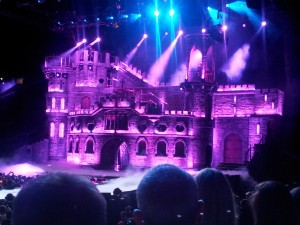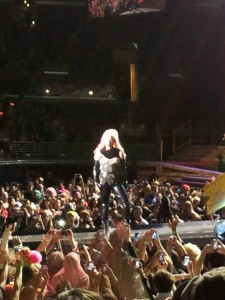
Lady Gaga’s purple castle of doom
Despite mixed metaphors of imprisonment, alien races, and meat, Lady Gaga’s Born This Way Ball tour stop at Los Angeles’s Staples Center on Sunday, January 20, stayed on point from start to finish. And if you consider the crowd a part of the show, as Gaga certainly does, her message began before the actual concert.
It’s never a bad move for an aspiring dance diva to court the queer vote, but Gaga seeks to become the gay icon to end all gay icons, embracing the gay gaze on a level that Garland, Minnelli, Streisand, and Ciccone never even dreamed possible. Her entire act revolves around the message of self-acceptance, her entire goal to make sure that this generation will be the last one to ever have members who might be afraid that being queer is in some way unacceptable. “Queer,” in Gaga’s world, represents the Q in LGBTQ, but she also invokes the broader sense of the word: you can be a straight weirdo, and that’s okay too.
Of course, Gaga‘s loud proclamation that you were Born This Way makes her a thumb in the eye for the surviving vestiges of the religious right’s old guard. But when she raises her middle finger at the last bastions of anti-gay intolerance, she takes the old rock ‘n’ roll-adjacent rebel-without-a-cause stance and elevates it to rebel with a cause — and a hit-making one at that.
Make no mistake: Lady Gaga is devil music, pure and simple. But it’s so much more cheerful than the darker folkways of the ’80s, when a black leather motorcycle jacket was worn with a sneer instead of a thong. The ersatz Satan-worshiping poseurs of ’80s metal, those Á¶ver-Á¼mlauted bands who received their zenith skewering in This Is Spinal Tap, in reality probably spent very little time placing candles in pentagrams, while Gaga has undoubtedly spent a lot of time thinking about the ways in which Christian-indoctrinated homophobia does harm to civil rights, self-esteem, and family relationships. Gaga doesn’t have to backwards-mask her church-unfriendly lyrics — play a Lady Gaga record backwards and you’ll probably just get an equally dancey tune.
Faking birth pains, Gaga emerged astride a giant, inflatable faux abdomen, legs akimbo. With costumes evocative of H.R. Giger doing drag, one of the central plot points in Sunday’s concert was the “birth of an alien race,” a not-too-difficult-to-decode metaphor for the queer people among us, of which Gaga was presented as mother and guardian. The oppressive force seeking to extinguish the aliens was depicted as a Madame Leota-style holographic head floating in a neon diamond — also Gaga — which appeared periodically to issue indecipherable orders until sometime late in the two-hour show, when the menacing and presumably homophobic head was anticlimactically vanquished.
In between all of that, Gaga showcased her relatively modest catalog of not-all-that-annoying hits — remember, she only has two albums — in an uberstar fashion, with predictable adulation from the utterly smitten, heavily LGBTQ audience. After all, no one has told them in such definitive and grandiose terms that they are so thoroughly okay until now, or at least not in such megaproduction style. Even Madonna’s clearly gay-friendly shows are more about depicting the queen and her eunuchs, with a bit of peace and love thrown in for good measure, than about advancing a plainly stated manifesto.
Though the music itself will never go down in history as particularly memorable when separated from its packaging, Gaga differs from her fellow pop megadivas in two other notable ways. In comparable pop acts the diva and her dancers are typically at center stage, the musicians a hidden afterthought. Gaga’s staging, by contrast, in the form of a giant, moveable castle, highlights her backing band, elevating them, both figuratively and literally, into the spotlight. Her respect for musicians, no doubt, is informed by her own musical training, which she highlights at several points during the show by — get this — actually playing an instrument. And it’s when Lady Gaga sits down at the piano that she refreshingly gives the superstar thing a rest and humanely connects with the audience, most touchingly during an acoustic reprise of “Born This Way” that’s addressed to a single audience member, singled out via cell phone. The Gaga phone-call moment feels like a contrived gimmick until you see the recipient melt, then see the audience do likewise. It’s corny, but it totally works.
There are a few moments that don’t work in the show — not in its staging, but in Gaga’s frequent insistence that everybody “GET UP AND DANCE!” or when she repeats demanding inquiries like “ARE YOU HAVING A GOOD TIME?” When Gaga raises her arms, jumps, and then explicitly explains to the audience that they’re supposed to do the same, it betrays a slight lack of confidence: a more seasoned performer would know that crowd control means owning it, certain in the knowledge that when you sway your arms over your head, the crowd will follow without you having to issue an ultimatum.
Although Gaga quite openly admits to being a “Fame Monster,” craving fame for its own sake, she also seems determined to use her fame to empower her fans while maintaining a sense of gratitude along the way. More than once during the evening she remarked on the cost of tickets and thanked people for saving up their hard-earned money. That was an unusual move — how often do performers refer to ticket prices onstage?
While most pop divas have their pet charities or favorite causes — Gaga’s no exception, seeing as how she raises money for LGBTQ homeless shelters — her more immediate work involves lifting up fans at her concerts by hammering home her moral: I’m fabulous, and you’re fabulous too. Rather than courting just the cool kids, Gaga’s goal is to invite everyone to this dance party, making her the perfect star for the no-dislike-button, friend-happy ’10s. If her queer-lifting pose is the new form of pop-star rebellion, and Gaga a new generation’s Antichrist, I say let’s go with it.






Comments